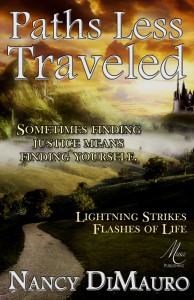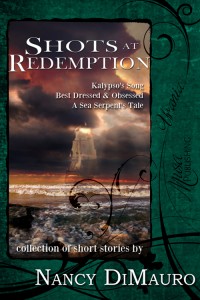 As you know from my post earlier this month, I have two short story collections published by Musa Publishing. I’m participating in an anthology – The Jack Gorman Project – that was born at an after-conference dinner at the 2011World Fantasy Con, The anthology will release on July 20, 2012. I also have a novella, Apollo Rising, that should be released in September, 2012. All as part of Musa’s line.
As you know from my post earlier this month, I have two short story collections published by Musa Publishing. I’m participating in an anthology – The Jack Gorman Project – that was born at an after-conference dinner at the 2011World Fantasy Con, The anthology will release on July 20, 2012. I also have a novella, Apollo Rising, that should be released in September, 2012. All as part of Musa’s line.
So, why did I choose E-publishing?
Well, let’s be honest, Musa said yes.
All kidding aside, I chose to E-publish rather than continue the short story publication rounds or wait on traditional publishers to deem me worthy for several reasons. But, before I go into those reasons, let me use Celina Summers’ definition of E-publishing from the June 1, 2012 blog.
According to Celina:
(E-Publishing) houses are digital first. They publish e-books primarily, although some are moving into POD(print on demand) availability for their books. An e-publisher is a genuine small house, following the same submissions, acquisitions, and editing processes as traditional publishing. Five years ago, e-publishing wasn’t considered a legitimate publishing credit by agents and New York publishers. That mindset is changing as the popularity of digital books increases.
Okay, now that we are all on the same page, let’s talk about why I chose this path.
Probably most importantly, I met Celina at World Fantasy. I liked her. We talked for hours about everything and nothing before she gave me permission to pitch her. I can’t stress how important this personal connection is in any form of publishing. I’m not sure I would have trusted my babies (the stories) to an e-publisher, especially one who’d just opened its doors, if I hadn’t met Celina.
On to more general reasons to consider an E-publishing house. I don’t have the time or energy to do all the work the fabulous people at Musa do for me. Self-publishing wasn’t an option for me. E-Publishing has all the benefits of traditional publishing. When I submit a story, a slush-pile reader has to like it enough to take it to the head editor for that genre. If the editor likes it, I get a contract. Once the story is under contract, it benefits from professional editing. Then it goes through line editing. So, we both know we’re publishing a book that’s as clean as possible. Musa has a professional artist that does my cover AND (unlike traditional publishing), for anyone but the N.Y. Time best sellers, I had significant input into what that cover looked like.
E-Publishing has the potential to pay better. Musa’s contract is on its website. You can see how your royalties will get calculated before you submit to it. If I’d sold my short stories to a magazine, I might get 6 cents a page. For a 15,000 word story, I’d be paid $900. It’s a good number, but that’s it until I get the rights back and resell it. Paths Less Travelled is a 15,000 short story collection being sold for $3.99. For Paths, I make that same $900 after I sell about 460 books. That’s not that hard to do. From book 461 on, I’m making more money than I could have by traditionally selling the short stories. It is potential that is up to me to realize. Musa will help, but success or failure sits on my doorstep. Which leads me to marketing.
As part of an E-Publisher’s line, you’ll get some limited marketing. But just like with traditional publishing the onus is on you to make sure your book sells. Musa helps me work on my marketing materials. In fact, Musa requires it. Musa won’t release a book unless its tags, blurb and excerpt are turned in. It also has pre-existing deals with Amazon, Barnes and Nobles and other vendors to get my book out to the public. There’s no one but myself to blame if I only sell 100 books. There’s a lot of people to thank if I sell 1,000, 10,000 or more books.
E-publishing also happens a lot quicker than traditional publishing. You might wait 2-3 years between signing a contract and a publication date with the Big 6. Not so with E-Publishing. As a new author, it’s highly unlikely that a traditional publisher would take a risk on four books in one year. And, as it is said, the best marketing for your current book is your next one. By allowing me to get more stories to my audience quicker, E-publishing helps me build a platform that I can convert into more sales and, maybe some day a print contract.
The nature of E-publishing allows those houses to take risks that traditional publishers just can’t afford. A significant portion of producing a book is in the actual printing process. E-Publishers don’t have this expense. Most first time novels lose money for the traditional houses. Think about that for a minute. A traditional publisher knows that most of its first time authors won’t earn their advance. As a result, a traditional publisher has to limit its exposure to these losses meaning it will be hesitant to take on an unpublished writer. Because of the significant difference in costs structures, E-publishers can take more risks with new writers. Just like I have the potential of making more money this way, an E-Publisher needs to sell fewer books than a traditional publisher to recoup its expenses and start making a profit.
E-Publishing makes novellas and short story collections viable. A novella is a story between 40,000 – 70,000 words. Magazines have problems with novellas. Often, they are too big, and take up too much space. This length of story poses two problems to traditional houses: First, the expense of producing one is about the same as producing a full novel. Second, the spine of the book is going to be too small to show up on a shelf. So, novellas have been a hard sell for traditional publishing. However, E-books breathed new life into novellas and collections. E-publishers don’t have to worry about spine size or shelf space. They can price a book at $1.99, and still earn a profit. Traditional publishers can’t. E-publishing created a market where none existed.
I can’t end this post without bragging about Musa, and how thrilled I am to be part of this house. So, bear with me. Here’s what makes Musa special. Musa is a community of writers. We support each other. We help each other market. Musa offers master classes to help us become more savvy business people and better writers. I don’t know anyone else out there that’s investing in its writers in this manner. Musa strives to provide more and better services to its writers and readers. We now have books on OverDrive, a library lending program. We have a vibrant blog. Again, if I don’t succeed to the level I want, I have no one to blame but myself.
So, yes, I chose E-publishing and it chose me. Does this mean I’ve given up on traditional publishing? No. I think they are both avenues that should be pursued. But I’m happy to be with this fabulous E-Publishing house. I chose it as much as it chose me.
 For my short story collections, Paths Less Traveled and Shots at Redemption, or a host of other amazing stories in just about every
For my short story collections, Paths Less Traveled and Shots at Redemption, or a host of other amazing stories in just about every genre, please check out Musa Publishing.
genre, please check out Musa Publishing.

